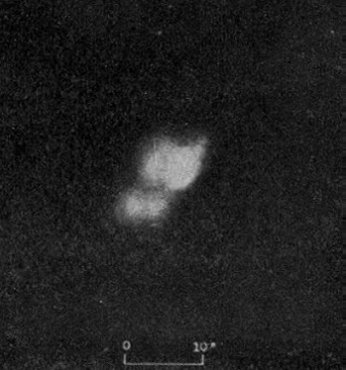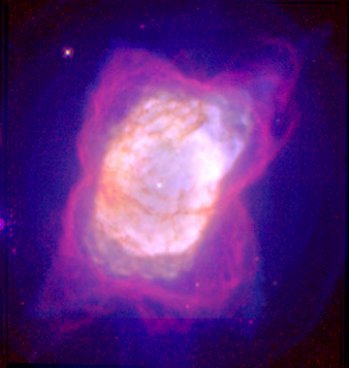NGC 7027
"Exceedingly bright" (Curtis). NGC 7027 lies in the thick of the
Milky Way in Cygnus,
5.5 degrees southeast of Deneb. With no
popular name or following, it's not only among the most examined of
planetary nebulae, but is without
much doubt historically among the most enigmatic, mostly the result
of a huge amount of local circum-nebular dust that grossly distorts
the optical view and hides the central star, giving the appearance
that this planetary has none at all (which could not possibly be
the case). On the left is Curtis's century old composite drawing
that gives a good sense of 7027's appearance through a modestly
large telescope. On the right is the spectacular Hubble view, a
composite of optical and infrared images, that (1) shows that the
nebula has a common bi-polar structure (already known from radio
images), (2) reveals the central star, and (3) dramatically shows
the dark dust lanes that hide much of the nebula in the visible
part of the spectrum.
Compare the two. In the old image on the left, north is directly
to the top, while in the Hubble image, north is tilted from the top
to the left by about 15 degrees. The visual structure on the left
is then quite obviously the result of the nebula's light shining
through the regions that are clear of the dark dust, which cuts
across the center, hiding the star. The dust, both circum-nebular
and interstellar, reduces the brightness of even the optical view
by more than three magnitudes. In spite of the odd structure and
dust, NGC 7027 is the standard object against which the measured
brightnesses of other nebulae are compared.
The distance of 2900 light years (known with an accuracy of about
15 percent) is found by comparing the expansion of the radio image
with an expansion velocity of around 18 kilometers per second
(though one source suggests 2200 ly). With a maximum angular
extent of 16 seconds of arc, the nebula has a physical span of just
under a quarter of a light year. The temperature of the 16th
magnitude (16.3) exciting star, 185,000 Kelvin, is one of the
highest known. Still in a heating and shrinking phase at near
constant luminosity, the star pumps out the energy of 5000 Suns, the vast majority of it in the energetic
ultraviolet. Highly enriched
in carbon from nuclear reactions in the precursor advanced giant star, as the nebula grows
and dissipates, it will add another load of this and other newly-
created elements into the interstellar medium for use by the new stars yet to come.
Left: Image and quote by H. D. Curtis from Publications of the Lick
Observatory, Volume 13, Part III, 1918. Right: William B. Latter
(SIRTF Science Center/Caltech) and NASA.



